The Chinatown Art Brigade fights for housing rights in one of the most gentrified cities in America
Ten years ago, when urban activists spoke of “gentrification” they might as well have been speaking of the Bogeyman. Often dismissed as so much liberal hand-wringing, gentrification was an urban phenomenon that few took seriously – at least, few in positions of power to do anything to curtail it – and many were convinced wasn’t even “real,” much like the early days of climate change denial.
Unfortunately the world is getting hotter, and gentrification is happening with blinding rapidity in major and mid-sized cities all over the country.
There is no easy answer to “why?” or “how?” The unique circumstances of our post-9/11 political era have created the conditions for this perfect storm. Everything has contributed – generous tax breaks to billionaire developers, a post-recession housing market in a chokehold from banks too gun-shy to issue traditional loans and cash buyers (often absentee “investors”) snatching up foreclosed properties at bargain basement prices, Millennials’ desire to live in cities, Citizens United, NIMBYs blocking affordable housing developments, the rise of Silicon Valley, corporate welfare, the sharing economy run amuck, wage stagnation, grotesque income inequality – which is precisely why it’s so hard to fight, much less reverse. The fact is, we’re watching it happen right in front of our faces, very little is being done to stop it, and the overwhelming majority of Americans are left feeling powerless.
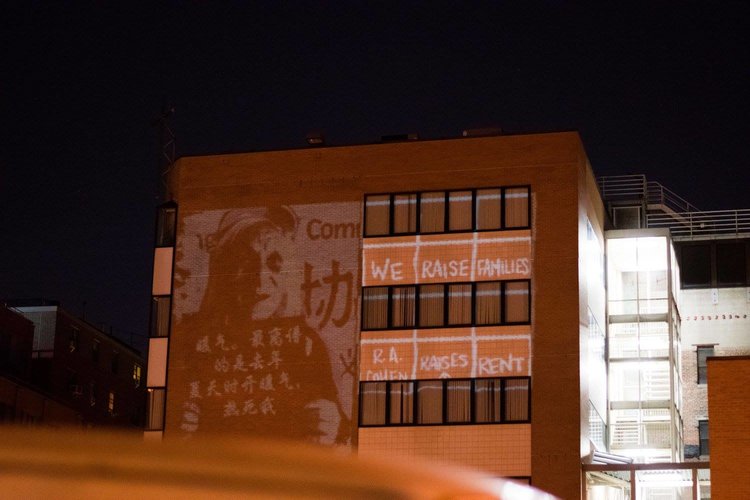
While gentrification can be difficult to succinctly explain, it boils down to this: money and politics. As in, those with the money control the politics, the politics dictate development, and development de facto decides who gets to live where.
On its surface, gentrification even appears to be a net good: who wouldn’t want nicer, safer, more beautiful cities with higher property values and wealthier tax bases? It is this deception that has made it all the more pernicious and justified even the well-intentioned of the wealthier classes to cheerfully cosign on this new American feudalism.
Unfortunately these “nicer, safer, more beautiful cities ” occurs at the expense of everyone else, with low-income communities and communities of color the most profoundly affected and systematically displaced. Also worth noting: “low-income” has taken on a much broader definition of late – in San Francisco, it means anything less than $117,400 for a family of four.
While this is happening in cities all over America, nowhere are the consequences of unchecked gentrification more evident than in New York City.
But there are those who are trying to fight it, to stop the bulldozer of rampant development from paving over their homes and their lives for the shiniest new self-contained castle for the super-rich.

The Chinatown Art Brigade (CAB) formed in 2015 in response to the rapid gentrification of New York’s Chinatown. They work closely with the Committee Against Anti-Asian Violence (CAAAV), a nonprofit group that organizes Asian-American communities to fight for social justice causes, and its housing rights program the Chinatown Tenants Union, an effort to bring together Chinatown citizens to provide a unified community voice on issues relating to gentrification and development.
Founded by artists Tomie Arai, ManSee Kong, and Betty Yu, CAB sought to increase the capacity of the work, labor, and housing rights organizing that CAAAV was already doing by moving beyond the direct action work of door-knocking and canvasing to creative engagement.
“We wanted to figured out how to integrate arts and culture organizing to help galvanize people,” Yu explains, but, she says, CAB quickly took on a life of its own. “We realized it was the right time and place because we were dealing with working class immigrant communities of color where arts and culture are being used to gentrify communities.”
Arts and culture have been the canary in the coalmine for cities all around America, signifying that moment just before gentrification really starts to get rolling. First come the murals, then come the millionaires. Yu says that CAB resists being yet another gentrifying arts project because of its “fundamental difference of approach.”
“We’re really disrupting the narrative of artists being used by developers to help gentrify neighborhoods,” she says. “There is a fundamental difference between creative placemaking projects and what we do. We call it ‘placekeeping.’ Our approach has always been to work with the people in the community most directly impacted by gentrification. We feel our asset as artists is that people tend to listen to us more. We have the ear of certain folks because we’re in certain spaces that perhaps tenants and activist groups aren’t.”
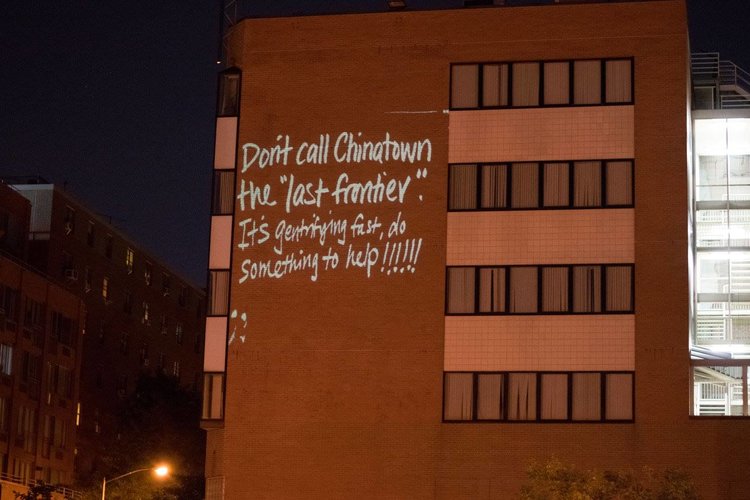
Yu paints a dire picture: since 9/11, Manhattan’s Lower East Side, which includes Chinatown, has lost 33,000 units of affordable housing. Rents have skyrocketed – where a family of four in Chinatown used to be able to find an apartment for under $1,000, now that figure is more like $4,000-5,000, even though that family of four still only makes $37,000. Most don’t qualify for affordable housing credits (for reasons of, quite simply, politics), not that it would make a difference with the inventory of affordable housing so low and the need for it so great.
Now, she says, it is not uncommon for 10 people to live in one single room occupancy unit. And yet, where the streets were once lined with independent mom-and-pop businesses owned by people of color, there sits no fewer than 130 art galleries. Yu says that while maybe six to eight of these galleries actually try to engage with the community, the rest are isolationist and purely profit-motivated. They can easily pay their rent by selling just one painting per month, and they have their own voting bloc.
“These contrasts are literally on the same block. That’s the kind of wealth gap that for us is so prominent these days, and our work is shedding light on that,” she explains.
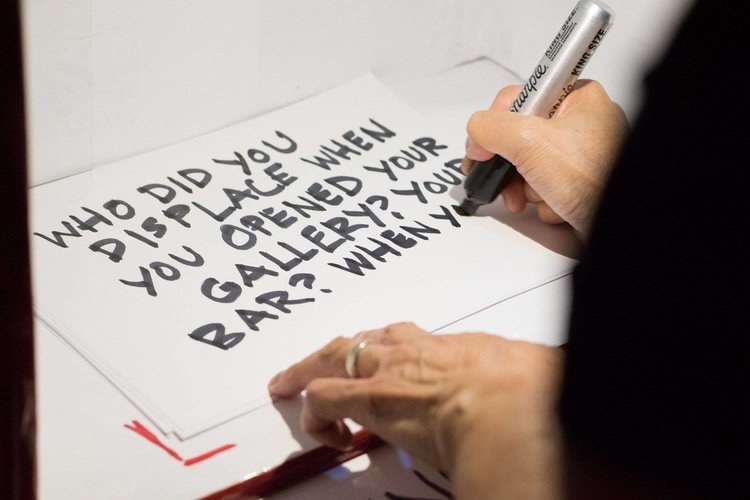
CAB takes their lead from the folks on the ground already doing the housing rights, environmental justice, and tenant organizing work, amplifying the voices that are almost always absent from mainstream media. They also work directly with residents of the community on their creative projects, ensuring that the work they’re doing and the messages they are conveying are a reflection of what the residents themselves want to communicate.
For the first two years of CAB they led projects called “Here to Stay” and “Chinatown is Not for Sale,” which came out of workshops with residents and tenants of Chinatown. They created messaging for giant projections that covered the sides of buildings at night.
“They wanted to reach other immigrant tenants about their rights, and let them know where there is organizing going on,” says Yu.
There was also a secondary audience for these projections: the galleries and gentrifiers. “We wanted them to know you’re not invisible. You’re not a bystander. You have to pick a side and be an ally.”
The third audience for these projections was policymakers because, ultimately, the policies that allow gentrification to happen are not fixed. Gentrification is not inevitable.
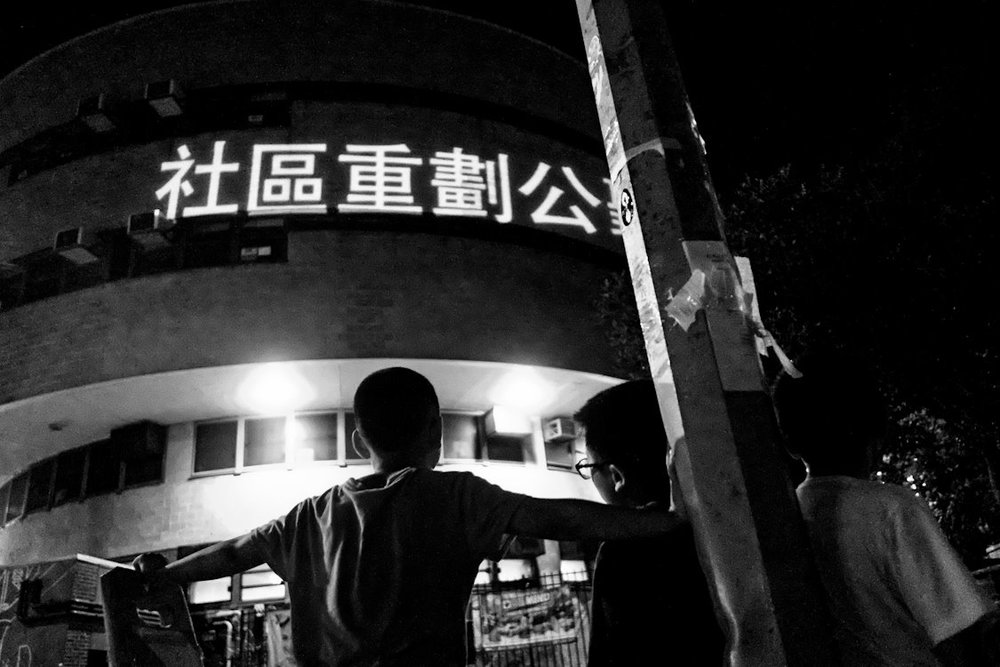
CAB’s next project is called “Placekeeping in Chinatown” and is currently being tested. After more workshops with residents, they found that people wanted something that was easily accessible on their mobile phones – items that have become necessary lifelines, even for the poverty-stricken who might not otherwise even have computers. CAB set out to create something that would give residents easy access to their rights on their phones while also preserving their mission of telling the stories of the people affected by displacement and gentrification.
They developed an augmented reality-based digital storytelling platform that will bring these stories to folks in Chinatown and beyond. When people view various storefronts, buildings, and signs through their phones a story will trigger – that might be photos of what that location previously looked like along with the story of that building’s significance to the neighborhood’s immigrant and worker population, such as being the site of the first union-organized restaurant in the area, or a building where tenants were successfully able to fight eviction. People can then hear the story of that first organized restaurant or of the tenants who fought eviction and won. These stories are also told in multiple languages – English, Chinese, and Spanish – for a diverse audience.
One such site of significance is a building where CAB co-founder Tomie Arai, who painted a lot of murals in Chinatown in the 1970s and ’80s, had painted a well-known mural with garment workers and restaurant workers – the people who were the backbone of Chinatown – on the side of the last live theatre venue in Chinatown. That site is now a hotel, one of two dozen in Chinatown alone.
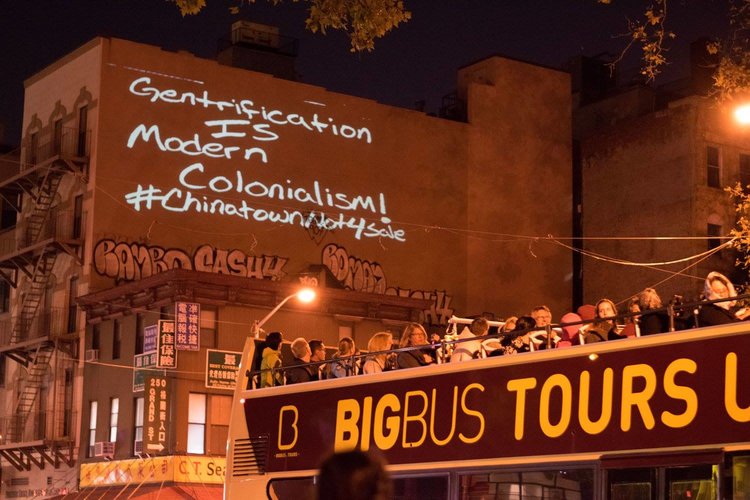
“The idea is to really bring these stories to life because of all the cultural erasure that has happened, which has so much to do with culture, art, and language,” says Yu. “[Developers and politicians] don’t want the gentrifers to know this history. They want to push this ‘blank slate’ narrative [and erase this history.]”
Because the Chinese community also likes to engage with QR codes, CAB will also place QR codes throughout the neighborhoods that will also trigger stories.
This project is currently in beta launch with nine sites being tested in order to gather community feedback and generate more stories. Yu says that they do not plan on fully launching until they have at least 12 sites fully activated.
CAB constantly grapples with and works actively to address the question, “How can artists not be weapons of mass displacement?” In an effort to answer that question, and to provide a simple guideline for other artists and arts organizations that do care about the communities they inhabit and want to be an ally, CAB developed an eight-pledge platform that includes items like “Get to know my neighbors,” “Support my neighbors who are fighting to save their homes,” and “Agree not to rent or buy any unit that is owned by a publicly known slumlord.”
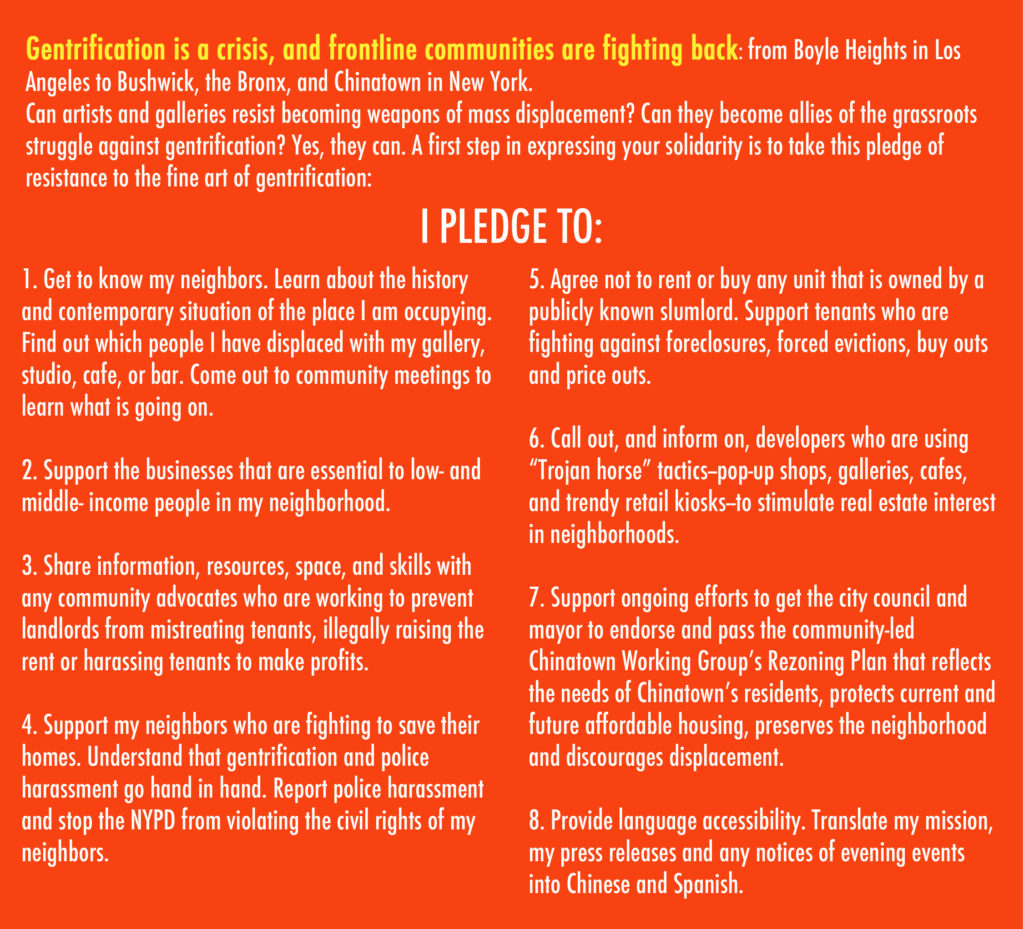
The platform urges business owners new to the community to make sure that their businesses are accessible to the community and integrate with the culture and the people already there. It also instructs business owners and artists to not allow themselves be used as “Trojan horses” for developers looking to inflate real estate value in the area.
“The advice in the platform is to look to the on-the-ground people who have been doing the organizing work so that you’re making a positive impact and not a negative one that leads to displacement,” says Yu. “Most people have good intentions, but [their presence] ends up raising real estate value. It is inevitably being used for that purpose. As much as we can we need to keep each other aware and [accountable], not just one group here and there but build a network sharing our stories and our practices. That’s really important: to share our experiences, then learn about how other places are fighting this.”
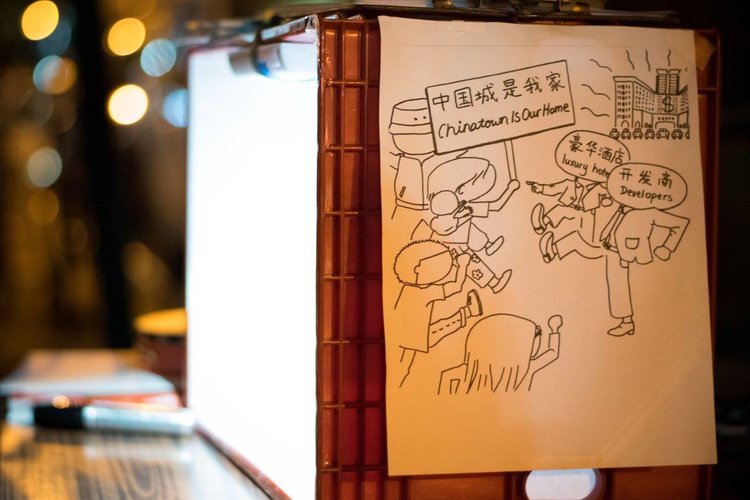
While CAB’s work has certainly galvanized Chinatown’s low-income and immigrant population, it also hasn’t gone unnoticed by the gentrifiers, whom Yu makes clear are not a monolith – many come into the neighborhood because they genuinely need a place to live and to them, it’s affordable.
One of those gentrifers is 74 Canal gallery owner Margaret Lee, who formed the Art Against Displacement coalition after attending a town hall meeting with CAB where she was forced to confront her own role in gentrification.
It is worth quoting her at length from an interview published by Are.na, because it demonstrates the extent to which those playing an active role in the gentrification process might truly have no idea that they are and no intention of doing so:
“After being held accountable for our part in the gentrification of Chinatown by the Chinatown Art Brigade at ‘Chinatown Is Not For Sale,’ I and other concerned members of the art community in Chinatown and the Lower East Side knew that we wanted to be part of positive change. I was asked publicly at the talk, ‘Why are you in Chinatown? Do you know who you’ve displaced by being here? Do you know that tenants in your neighborhood are being harassed? Do you know that tenants in your neighborhood are being displaced? Do you know that people are suffering around you?’
‘I had to quickly come to terms with the fact that I was ignorant to local Chinatown/LES issues. While I think that I am an active part of the community in Chinatown, and that I have the right to be in Chinatown, and that I enjoy being in Chinatown, I did take it to heart that I was not paying as much attention at a local level as I should be as a business owner. So I apologized for not being more active and I asked how I could become more active. After the town hall, I hosted a meeting at my gallery and invited dealers and artists to meet with the Chinatown Art Brigade to discuss their pledge. The pledge has eight tenets that they suggest people in the neighborhood follow so that they minimize their impact on the community.”
Yu uses Lee’s galvanizing action as an example of how the work that CAB does can create allies instead of enemies out of those new businesses coming in and inadvertently displacing others.
“They didn’t want to be labeled as the bad people, but [our point at that town hall was] ok, you showed up, what do you do now?”
For Lee, that meant fully adopting CAB’s pledge and being allies of CAB, the Coalition to Protect Chinatown & The Lower East Side, and the Chinatown Working Group. And for Yu, that was the whole point.
“The platform is not just a guide for individuals on ‘how do you not be an asshole,’ but how do you confront the system of gentrification, combat it, and disrupt it as an individual and as an institution,” she says.

(1) How do you like to collaborate?
Collaboration looks different depending on the project but at the heart of it is working with the people and communities who are most impacted by the issue(s) being elevated. And most importantly that they feel agency in how their story is being shaped and presented to a larger audience.
(2) How do you a start a project?
Usually I have to feel a personal connection and stake to the issue and of course I have to ask myself, am I the right person to tell these stories?
(3) How do you talk about your value?
My value is my empathy toward people and honoring their experiences, and my passion for justice. This drives my work.
(4) How do you define success?
I measure success by the people I’ve been able to reach, move, or even anger. I hope my work provokes people to think about that particular issue and the people impacted by it and ideally be informed and take action.
(5) How do you fund your work?
Funding seldom determines whether I will work on a project or not, especially if I’m passionate about it. But when I am seeking funding for a project, I fundraise for them through foundations, artist residencies, and on occasion receive generous donations from individuals.
